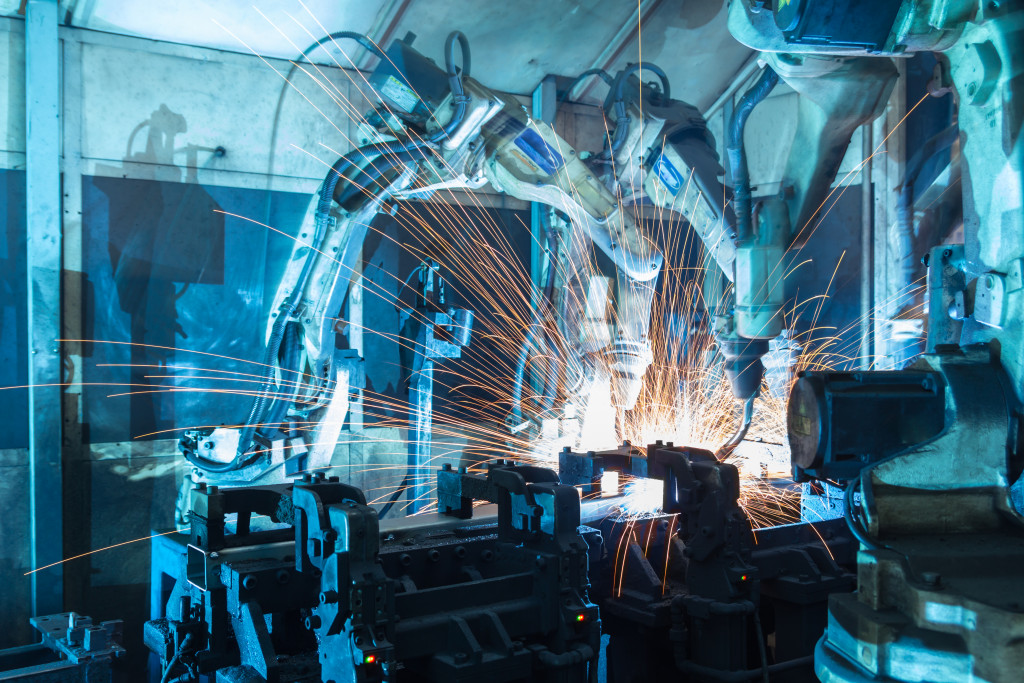- Automation is vital for streamlining modern manufacturing operations, increasing efficiency, reducing errors and downtime, and improving product quality.
- Robotic arms are commonly used for assembly processes, machine handling, paint spraying, and quality control.
- Accuracy tools like remote vibration sensors and optical scanners help ensure that parts meet high precision standards.
- Safety automation systems detect potential hazards and alert workers to keep them out of harm’s way.
Automation has become an essential tool in modern manufacturing operations. Automated processes are far more efficient, reliable, and cost-effective than manual ones. Automation can increase a factory’s productivity by reducing errors and downtime, simplifying complex procedures, and improving product quality. As a result, many factories have adopted automation technologies to streamline their production processes.
According to the International Federation of Robotics (IFR), industrial robots have been used in manufacturing for over 60 years, with the number of globally installed globally increasing yearly. In 2020 alone, nearly 400,000 industrial robots were shipped worldwide—a record.
However, you might not know where automation fits in your operations. Here are a few automation tips to help you get started.
Utilize Robotic Arms
Robotic arms are one of the most common forms of automation used in industrial operations, and they have become increasingly sophisticated and capable of performing more complex tasks. Identifying where robotic arms can be helpful is essential in automating a factory’s operations. Here are some examples of where robotic arms can be employed:
Automated Assembly Processes
The use of robotic arms for automated assembly processes has grown steadily over the past few years. They are commonly utilized to precisely position parts, apply adhesives, rivets, and other fasteners, and perform welding and cutting tasks. Robotic arms are handy when assembling delicate products like electronic components with precision and repeatability.
Machine Handling
Robotic arms are also great tools for efficiently handling machines or large objects—moving them from one location to another or rotating them quickly—without compromising safety or accuracy. This makes them ideal for loading or unloading materials, transporting goods between production lines, or fabricating large structures like aircraft.
Paint Spraying
Robotic paint spraying is becoming increasingly popular in manufacturing because it delivers a uniform coating on parts faster than manual painting techniques. Automated paint-spraying systems typically consist of two robotic arms: one with a paint gun and another that moves the position relative to the gun at a precise angle and speed. These systems can be programmed with different patterns for products requiring specific shapes or sizes for their coatings.
Quality Control
Quality control is another area where robotic arms can benefit manufacturing operations. With precise vision guidance systems attached, they can accurately detect defects in parts and components before entering downstream processes or the market. They can also sort products according to size, shape, color, weight, and other criteria within seconds—a task that would take humans much longer to do manually.
Adding Accuracy Tools

Accuracy tools are essential for manufacturing operations as they help to ensure that the finished product is of the highest quality. These tools typically involve sensors, such as remote vibration monitoring, to detect anomalies or problems with machinery or parts. By using these tools, factories can quickly and accurately identify issues that must be addressed before they become more significant problems and cause costly downtime.
Remote vibration monitoring sensors are a great example of accuracy tools used in manufacturing settings. These sensors measure vibration levels at different points on machines or parts to detect even the slightest changes in their performance. This information can then be used to identify any potential issues before they cause further damage down the line. Additionally, these sensors can maintain regularly scheduled maintenance checks and ensure that machines are running at their optimal efficiency levels.
Other accuracy tools include optical scanners, barcode readers, and RFID tags, which allow manufacturers to track and trace components during assembly processes for better quality control. They also make it easier for factories to keep tabs on inventory levels and production schedules to deliver products on time. Finally, automated inspection systems are becoming increasingly popular for ensuring high standards of accuracy throughout the entire manufacturing process.
Creating Safety Automation

The safety of workers is a priority in any manufacturing environment. Automation can help to reduce the risk of injury and increase overall productivity by automating tasks that require repetitive movements or involve hazardous materials. Safety automation systems are designed to detect potential hazards and alert workers of their presence through visual, auditory, or physical indicators before they become dangerous.
This type of automation includes implementing automated lockout/tagout procedures, utilizing robotic arms with vision systems for machine guarding, and employing automated guided vehicles (AGVs) to transport heavy loads without manual assistance. Safety automation systems can also be used to monitor the temperature of production environments, control access to restricted areas, and provide other warning signals when necessary.
Final Thoughts
Automation is essential for modern manufacturing operations, as it helps to reduce costs, improve quality, and increase safety. By utilizing robotic arms, accuracy tools, and safety automation systems to streamline processes and keep things running smoothly, factories can maximize efficiency and yield more profitable returns. With the right approach to automation, factories can become much more productive—allowing them to remain competitive in today’s ever-changing business landscape.




